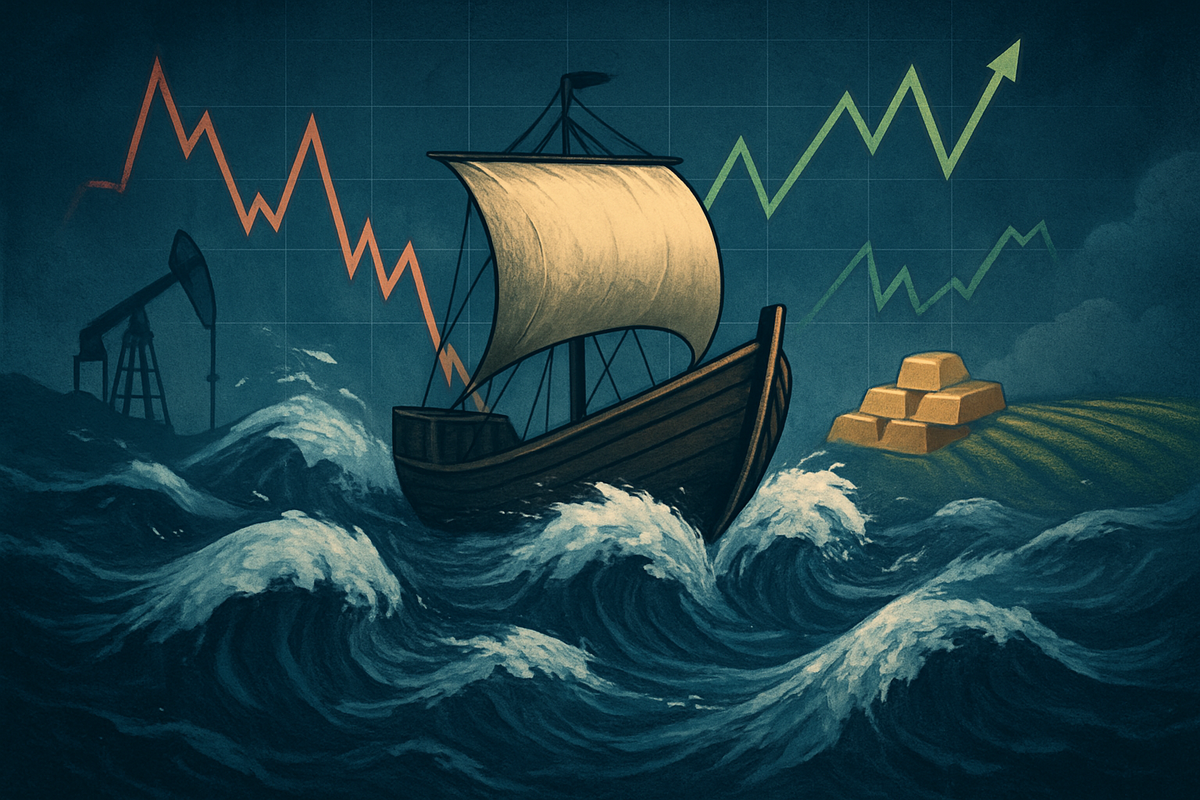
As of November 2025, global financial markets find themselves in a persistent state of heightened volatility, a multi-year trend driven by a complex interplay of geopolitical tensions, evolving monetary policy expectations, and ongoing concerns about asset valuations. This turbulent environment has led to significant and often unpredictable fluctuations across commodity prices, creating both formidable challenges and unique opportunities for investors worldwide. From the surging prices of precious metals and industrial materials to the divergent paths of oil and natural gas, understanding these dynamics is paramount for safeguarding and growing portfolios.
The immediate implications for investors are clear: heightened anxiety, increased risk of panic selling, and an urgent need for strategic reassessment. The Cboe Volatility Index (VIX) continues to show notable fluctuations, reflecting periods of intense investor apprehension, with major indices frequently experiencing daily movements exceeding 2%. In this climate, disciplined investing, robust diversification, and a long-term perspective are not just advisable but crucial for navigating short-term noise and identifying resilient opportunities amidst the storm.
Unpacking the Market's Tumultuous Ride
The current market turbulence is a culmination of several impactful events and trends. A significant jolt to the system occurred on April 2, 2025, dubbed "Liberation Day," when new tariff policies introduced by U.S. President Donald Trump triggered a global stock market crash. This announcement led to widespread panic selling, marking the largest global market decline since 2020, with the S&P 500 experiencing its sharpest two-day decline since the COVID-19 pandemic and over $6.6 trillion wiped off major indices. Although the Trump administration paused tariff increases on April 9, leading to a swift market rally, the underlying fragility remained. More recently, early November 2025 saw a tech-led slide, particularly among major artificial intelligence (AI) related stocks, causing a sharp but brief downturn that was quickly met with a rapid influx of "buy the dip" interest, underscoring the market's current resilience and investor sentiment.
Commodity markets have been a key driver and indicator of this volatility. Crude Oil (WTI) has seen downward pressure, falling to $60.20 USD/Bbl on November 12, 2025, amidst global supply outpacing demand from key players like Russia, OPEC, and the United States. In stark contrast, U.S. natural gas (Henry Hub) surged to $4.55 USD/MMBtu, experiencing a significant monthly rise of nearly 46%, fueled by tight supply-demand dynamics, expectations of a colder December, higher power demand, and robust export activity, especially to major U.S. LNG plants. Meanwhile, precious metals have been on a scorching rally, with Gold reaching $4,149/oz and Silver hitting a record $54.50 per ounce in October, consistently holding elevated levels through early November, serving as traditional safe havens amidst political instability and monetary policy uncertainty. Industrial metals are also ascendant, with Copper climbing to a London Metal Exchange record of $11,200 per metric ton ($5.09 per pound) in late October, driven by widening global supply deficits exacerbated by supply chain disruptions, labor strikes, and weather-related delays. Lithium prices have also risen, while steel remains bearish. Agricultural commodities present a mixed picture: wheat and corn have seen recent declines but also monthly increases, while soybeans have risen, potentially supported by China's plans to lift retaliatory tariffs on U.S. agricultural products.
Key players influencing these dynamics include governments and central banks, notably U.S. President Donald Trump with his trade policies, and the Federal Reserve, whose monetary policy decisions, including potential interest rate cuts, significantly impact market sentiment and asset valuations. OPEC+ continues to wield considerable influence over global oil supply, while China's economic growth and demand remain a critical factor for oil, metals, and agricultural products. Major commodity producers, from oil fields in the U.S. and Russia to copper mines in Chile and Peru, along with the collective actions of investors and traders, all contribute to the market's current state of flux.
Winners and Losers in the Commodity Crosscurrents
The current commodity landscape creates distinct winners and losers among public companies, depending on their exposure and operational leverage to specific raw materials. Companies in the energy sector, particularly those involved in U.S. natural gas production, stand to benefit significantly from the surge in natural gas prices. Firms like EQT Corporation (NYSE: EQT) and Chesapeake Energy Corporation (NASDAQ: CHK) could see improved profitability. Conversely, the downward pressure on crude oil prices, while potentially challenging for some oil producers, might offer a silver lining for energy-intensive industries like airlines, such as Delta Air Lines (NYSE: DAL) and Southwest Airlines (NYSE: LUV), by reducing fuel costs.
The record-breaking rally in precious metals like gold and silver bodes well for mining companies focused on these commodities. Barrick Gold (NYSE: GOLD) and Newmont Corporation (NYSE: NEM) are examples of companies that could experience enhanced revenues and investor interest as safe-haven demand remains robust. Similarly, the extraordinary momentum in copper prices benefits major copper miners like Freeport-McMoRan (NYSE: FCX) and Southern Copper Corporation (NYSE: SCCO), who are poised to capitalize on widening global supply deficits. The rising lithium prices also indirectly support companies involved in electric vehicle (EV) battery manufacturing and the broader EV supply chain, although direct mining exposure would see the most immediate benefit.
On the other hand, companies heavily reliant on these surging input costs could face margin pressures. Manufacturers that use significant amounts of copper or other industrial metals, without effective hedging strategies, may see their production costs rise, impacting profitability. The bearish trend in steel prices, influenced by subdued demand and oversupply, could continue to challenge steel producers such as United States Steel Corporation (NYSE: X) and Nucor Corporation (NYSE: NUE). In the agricultural sector, while some companies like Bunge Global SA (NYSE: BG) (soybeans) and Archer Daniels Midland (NYSE: ADM) (corn/wheat) might see mixed results depending on specific commodity price movements and their diversified portfolios, those with concentrated exposure to falling prices could face headwinds. The lifting of Chinese tariffs on U.S. agricultural products could provide a demand boost for companies exporting to China.
Wider Significance and Historical Context
This era of elevated market volatility and commodity price fluctuations fits squarely into broader industry trends marked by persistent inflation concerns, evolving global growth trajectories, and increasingly complex geopolitical landscapes. Commodities are increasingly viewed not just as raw materials but as a critical hedge against inflation and a strategic play on global economic growth. The supply chain disruptions that have plagued industries for years continue to contribute to commodity price instability, as seen with copper, where labor strikes and weather-related delays exacerbate supply deficits.
The regulatory and policy implications are profound. The tariff policies enacted by the U.S. administration have demonstrated their immediate capacity to trigger widespread market reactions, highlighting the direct link between political decisions and financial market stability. Central banks, particularly the Federal Reserve, play a crucial role in managing this volatility through monetary policy. Expectations of potential interest rate cuts, possibly as early as December 2025, are closely watched, as such moves could further support non-yielding assets like gold and influence overall market liquidity. Historically, periods of significant geopolitical tension and economic uncertainty have often coincided with surges in safe-haven assets and volatile commodity markets, drawing parallels to previous crises where investors sought refuge in tangible assets. The current environment echoes the commodity supercycles of the early 2000s and other periods of rapid industrialization and supply constraints, albeit with added layers of complexity from climate change impacts and advanced technological demands (e.g., for lithium).
What Comes Next: Navigating Future Horizons
Looking ahead, the short-term outlook suggests a continuation of elevated market volatility, with potential sharp swings driven by economic data, geopolitical developments, and corporate earnings reports. The "buy the dip" mentality, while providing temporary market resilience, also indicates an underlying tension that could lead to more significant corrections if fundamental conditions deteriorate. In the long term, the trajectory of inflation, the pace of global economic growth, and the stability of supply chains will be critical determinants. A significant commodity shock, particularly in energy or key industrial metals, remains a potential trigger for a broader economic slowdown or even a recession.
Strategic pivots and adaptations will be essential for both companies and investors. Companies will need to prioritize robust hedging strategies to mitigate commodity price risks, diversify their supply chains, and invest in efficiency to reduce reliance on volatile inputs. For investors, continued emphasis on diversification across asset classes, including a strategic allocation to defensive sectors like healthcare and utilities, alongside short-term bonds, will be crucial for managing risk. Emerging market opportunities may arise in cyclical commodities, particularly industrial metals and energy, for those willing to embrace higher risk. The potential for Federal Reserve interest rate cuts could create opportunities in fixed income and further bolster non-yielding assets.
Potential scenarios range from a "soft landing" where central banks successfully navigate inflation without triggering a recession, leading to a more stable market with moderate growth, to a more challenging "hard landing" scenario characterized by a recession and prolonged market downturn. Another possibility is a continued "stagflationary" environment, where high inflation persists alongside sluggish economic growth. Investors should prepare for a range of outcomes by maintaining liquidity, regularly rebalancing portfolios, and focusing on high-quality assets with strong fundamentals.
Comprehensive Wrap-up: Staying Resilient in a Dynamic Market
In summary, the current financial landscape is defined by persistent market volatility and significant fluctuations in commodity prices, driven by a confluence of geopolitical events, evolving monetary policies, and supply-demand imbalances. Key takeaways include the critical role of diversification and risk management, the appeal of safe-haven assets like gold and silver during uncertainty, and the strategic importance of understanding how commodity price movements impact various sectors and individual companies.
Moving forward, the market is likely to remain dynamic and unpredictable. Investors must remain vigilant, adapting their strategies to prevailing conditions. The interplay between central bank actions, global trade policies, and fundamental supply-demand dynamics in commodity markets will continue to shape investment opportunities and risks. The resilience of the "buy the dip" investor mentality, coupled with underlying economic concerns, suggests that while sharp downturns may be met with buying interest, the overall market environment will demand caution and strategic foresight.
What investors should watch for in the coming months includes any shifts in central bank rhetoric regarding interest rates, further developments in international trade policies, the stability of global supply chains, and specific reports on commodity inventories and demand forecasts. Monitoring earnings reports from companies across different sectors will also provide crucial insights into how businesses are navigating these challenging conditions. Ultimately, a well-informed, disciplined, and adaptable approach will be the cornerstone of successful investing in this era of elevated market volatility.
This content is intended for informational purposes only and is not financial advice





